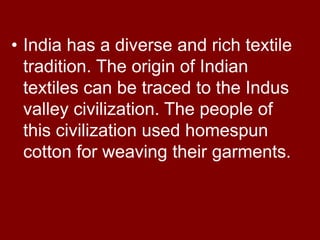indian art and textiles
- 1. âĒ India has a diverse and rich textile tradition. The origin of Indian textiles can be traced to the Indus valley civilization. The people of this civilization used homespun cotton for weaving their garments.
- 14. âĒ Excavations at Harappa and Mohen -jo- Daro, have unearthed household items like needles made of bone and spindles made of wood, amply suggesting that homespun cotton was used to make garments. Fragments of woven cotton have also been found from these sites.
- 17. âĒ Though silk is associated with China, which had a highly developed sericulture industry during the Neolithic period, 4000 years ago, it was also produced in India after the monks brought it from China and from the earliest times and was treated as a cloth of purity, to be used for ritual purposes.
- 18. âĒ Buddha had permitted bhikkus the use of kauseya-pravare, a silken chadar. Though no actual examples exist, literary references to silk weaving with wild or uncultivated silk was known in India previous to recorded history. We know that the forests of Bengal and Assam had a range of Bombaycidae and Satumidae cocoons. These were collected by the tribals and woven by the people of the plains.
- 19. âĒ According to Confucius, it was in 2640 B.C. that the Chinese princess Xi Ling Shi was the first to reel a cocoon of silk which, legend also has it, had dropped into her cup of tea. From that historic moment, the Chinese discovered the life cycle of the silk worm and for the next 3000 years were to keep their monopoly of silk.
- 20. âĒ In the 3rd Century B.C., Chinese silk fabrics were beginning to find their way throughout the whole of Asia, and were transported overland to the west, and by sea to Japan, in those long itineraries known as the silk roads. It was in Asia that the Romans discovered these wondrous fabrics but they knew nothing of their origin.
- 21. âĒ In 552 A.D., the Emperor Justinian sent two monks on a mission to Asia, and they came back to Byzantium with silkworm eggs hidden inside their bamboo walking sticks. From then on, sericulture spread throughout Asia Minor and Greece.
- 22. âĒ In the 7th Century, the Arabs conquered the Persians, capturing their magnificent silks in the process, and helped to spread sericulture and silk weaving as they swept victoriously through Africa, Sicily and Spain. In the 10th Century, Andalusia was Europe's main silk-producing centre.
- 23. âĒ It is said that when Buddha attained Nirvana (eternal rest), his body was wrapped in a Benares fabric, which shot rays of dazzling blue, red and yellow.
- 25. âĒ The first literary information about textiles in India can be found in the Rigveda, which refers to weaving. he Rig-Veda refers to the hiranyadrapi or a shining, gold - woven cloth, âĒ the Mahabharata to the manichera and Valmiki's Ramayana describes Ravana, the demon god, as donning a gold fabric. âĒ Pali literature mentions the Kaseyyaka (silk of Benares) worth a hundred pieces of silver. The ancient Indian epics-Ramayana and Mahabharat also speak of a variety of fabrics of those times. The Ramayana refers to the rich styles worn by the aristocracy on one hand and the simple clothes worn by the commoners and ascetics.
- 26. âĒ The weaving of fine, gossamer-like silk has been a tradition in Benares since 500 B.C. During the Mughal period (from the early 16th through the mid-18th century), Islamic religion forbade the depiction of animals and people, thus fostering the elaborate floral brocades that made Benaras famous. This is when motifs such as the creeping vine and the mango design, the inspiration for European paisley, developed.
- 29. âĒ Ample evidence on the ancient textiles of India can also be obtained from the various sculptures belonging to Mauryan and Gupta age as well as from ancient Buddhist scripts and murals (Ajanta caves). Legend has it that when Amrapali, a courtesan from the kingdom of Vaishali met Gautam Buddha, she wore a richly woven semi transparent sari, which speaks volumes of the technical achievement of the ancient Indian weaver.





























































































































